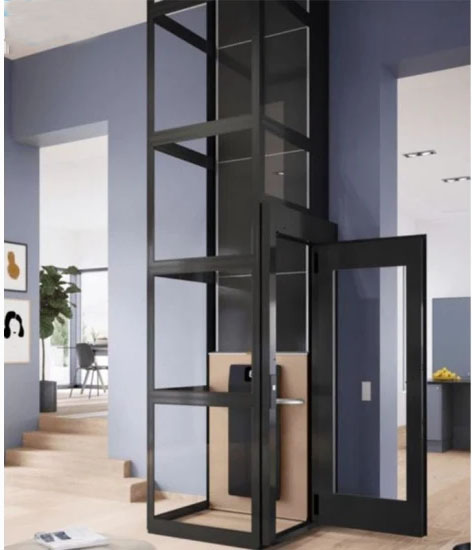Gantry Frame Traction Home Elevator
Similar to the reduced version of the office building elevator, the use of counterweight and car balance principle, guide rails are located on both sides of the car, the force is uniform, by the permanent magnet synchronous gearless traction host through the steel wire rope to drive the car up and down running, no need to change the oil, no pollution, green and low maintenance costs, guide wheel and the track between the force is not, the operation of the safe, stable and noiseless.
Advantages: mature technology, wide range of applications, guide rails are located on both sides of the car, uniform force, smooth operation, low power consumption, fast speed.
Disadvantages: the size of counterweight occupies a large area, the same car area, the shaft should be more than the size of the counterweight placed.

Backpack Type Traction Home Elevator
The backpack type traction ascensor de casa has the car guide rail on one side of the car, similar to a student’s backpack. The advantage of this design is that the left and right sides of the car are no longer set up car guide rails, saving the size of the shaft on both sides.
Advantages: unique design structure, 90 degrees open door, and even can be opened on all three sides, the elevator only need to have a face to connect with the current building, low requirements for the building structure, adaptability, low requirements for the shaft building, simple and convenient.
Disadvantages: Since the guide rail is only on one side, the car will be in friction with the guide rail on one side because of the weight during operation, which will easily cause the guide shoe to wear out, unstable operation and abnormal noise after long-term operation.

Forced-Drive Traction Home Elevator
The only difference between a forced traction elevator and a gantry frame elevator is that there is no counterweight, and the car is driven up and down by the motor driving the traction wheel rotation.
Advantages: saving space in the shaft; strong safety, no safety accidents of the elevator car or counterweight hitting the floor.
Disadvantages: the elevator host power is large, generally in 4KW-5KW, is about 2 times of the traction counterweight elevator.

If you still have questions about how to choose, please feel free to contact Dazen Elevator. We will provide you with personalized professional advice to ensure that you choose the most suitable elevator for your home and improve your quality of life!

